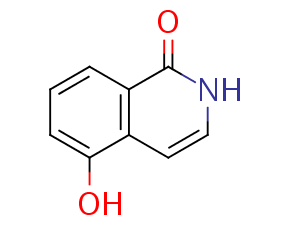
1,5-Isoquinolinediol
CAS No. 5154-02-9
1,5-Isoquinolinediol( —— )
Catalog No. M17727 CAS No. 5154-02-9
1, 5-Isoquinolinediol is an inhibitor of poly(ADP-ribose) synthetase (PARP1; IC50: 0.39 μM).
Purity : >98% (HPLC)
 COA
COA
 Datasheet
Datasheet
 HNMR
HNMR
 HPLC
HPLC
 MSDS
MSDS
 Handing Instructions
Handing Instructions
| Size | Price / USD | Stock | Quantity |
| 5MG | 52 | In Stock |


|
| 10MG | 78 | In Stock |


|
| 50MG | 172 | In Stock |


|
| 100MG | Get Quote | In Stock |


|
| 200MG | Get Quote | In Stock |


|
| 500MG | Get Quote | In Stock |


|
| 1G | Get Quote | In Stock |


|
Biological Information
-
Product Name1,5-Isoquinolinediol
-
NoteResearch use only, not for human use.
-
Brief Description1, 5-Isoquinolinediol is an inhibitor of poly(ADP-ribose) synthetase (PARP1; IC50: 0.39 μM).
-
Description1, 5-Isoquinolinediol is an inhibitor of poly(ADP-ribose) synthetase (PARP1; IC50: 0.39 μM). The poly(ADP-ribose) polymerases (PARPs) form a family of enzymes with roles in DNA repair and apoptosis. 1, 5-Isoquinolinediol has been used to study the role of PARP1 in both DNA repair and oxidant stress-induced cell death. This compound can be used with cells in culture and in animals.
-
In Vitro1,5-isoquinolinediol leads to an increase up to 8-fold in the absolute frequency of gene targeting in the correction of the mutation at the stable integrated HSV tk gene.1,5-Isoquinolinediol is a potent PARP antagonist and decreases cleaved PARP in diabetic retina.1,5-Isoquinolinediol (500 μM H2O2; 24 hours) attenuates H2O2-induced upregulation of cleaved PARP-1 expression in retinal Muller cells. 1,5-Isoquinolinediol attenuates diabetes-induced upregulation of retinal nitrated protein expression. 1,5-Isoquinolinediol attenuates diabetes-induced activation of NADPH oxidase in the retina.
-
In Vivo——
-
Synonyms——
-
PathwayOthers
-
TargetOther Targets
-
RecptorPARP1
-
Research Area——
-
Indication——
Chemical Information
-
CAS Number5154-02-9
-
Formula Weight161.16
-
Molecular FormulaC9H7NO2
-
Purity>98% (HPLC)
-
SolubilityIn Vitro:?DMSO : 37.04 mg/mL (229.83 mM)
-
SMILESOc1cccc2c1cc[nH]c2=O
-
Chemical Name——
Shipping & Storage Information
-
Storage(-20℃)
-
ShippingWith Ice Pack
-
Stability≥ 2 years
Reference
1. Davar D, et al. Role of PARP inhibitors in cancer biology and therapy.[J]. Current Medicinal Chemistry, 2012, 19(23).
molnova catalog



related products
-
Anthracophyllone
Anthracophyllone is a natural product from the mushroom Anthracophyllum sp. BCC18695.
-
Menbutone
Menbutone is an organic compound with fomula C15H14O4.
-
trans-2-Methyl-2-pen...
2-methyl-2-pentenoic acid also known as strawberry acid has a sweet berry-like aroma and flavor and is widely used in food flavor.



 Cart
Cart
 sales@molnova.com
sales@molnova.com


